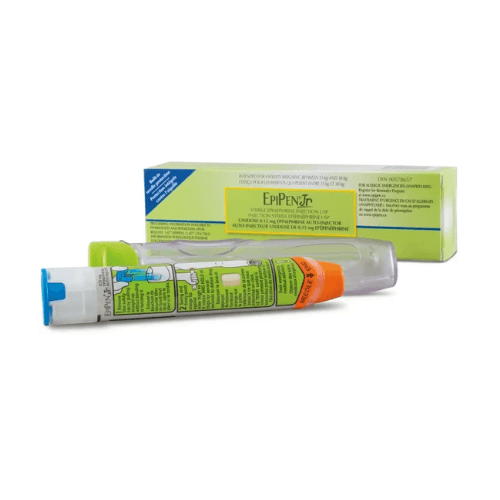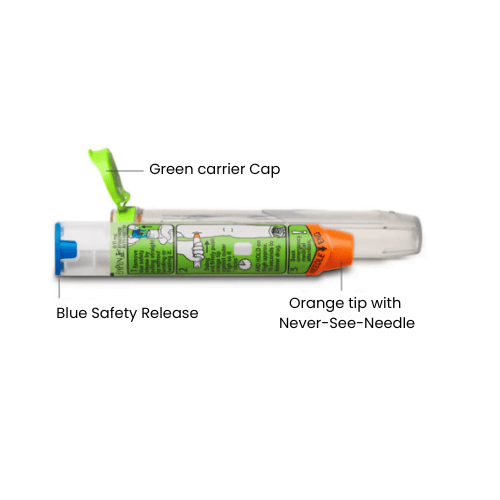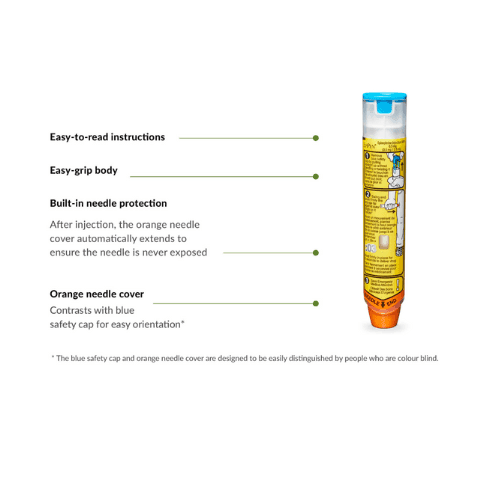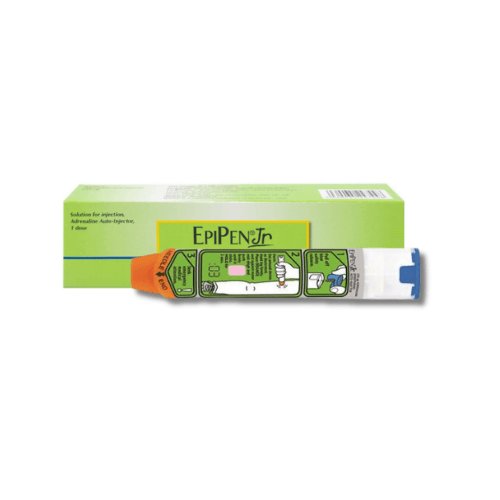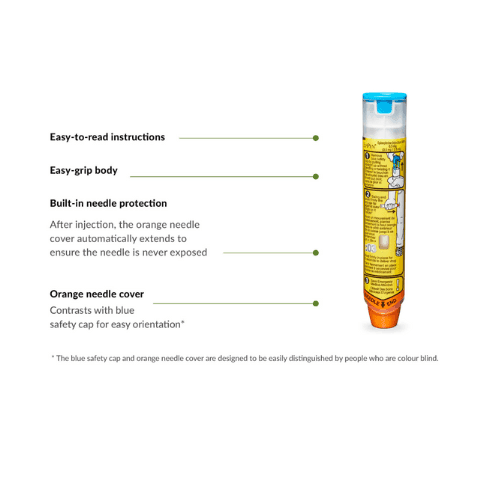Shipping with this method takes 3-5 days
EpiPen Jr® Auto-Injector for Anaphylaxis
Stock up and Save - Get 20% off when you buy 3 or more of any one product. Use code SAVE20 at checkout.
Coupon code cannot be combined with other offers. Sale applies to all products originating from Canada. Maximum allowable quantity equal to a 90 day supply per single order.
$125.99
Secure Encrypted Payments
An epinephrine auto-injector treats life-threatening allergic emergencies. This page explains how the pediatric device works, how to use it, and what to expect. We offer US shipping from Canada so you can plan ahead if you need an epinephrine auto-injector without insurance.
What EpiPen Jr Is and How It Works
EpiPen Jr® delivers a measured dose of epinephrine during a severe allergic reaction. The medicine constricts blood vessels, relaxes airway muscles, and can reduce swelling in the throat and lungs. It may quickly improve breathing and blood pressure until emergency care takes over.
YouDrugstore is a licensed Canadian pharmacy in Manitoba. Pharmacists review prescriptions before dispensing.
The device is designed for fast, single-step activation. It can be used through clothing in an emergency. Training with a non-medicine trainer helps caregivers act confidently and reduce handling mistakes.
Who It’s For
This pediatric auto-injector is intended for children at risk of anaphylaxis, including those with serious food, insect, medication, or latex allergies. It is typically used for kids who weigh about 15 to 30 kilograms, based on labeling and clinician guidance. Children who exceed the pediatric weight range may require a different strength as directed by a prescriber. Infants under the lowest weight range need individualized advice from a clinician.
People with heart disease, high blood pressure, or thyroid disorders should discuss risks and benefits with a healthcare professional. Even with these conditions, epinephrine remains first-line treatment for anaphylaxis. The goal is rapid symptom control while arranging emergency care.
Dosage and Usage
Use the injector at the first sign of anaphylaxis, such as trouble breathing, throat tightness, widespread hives with swelling, or faintness. Remove safety caps as shown in the instructions. Place the orange tip on the mid-outer thigh, press firmly until it activates, and hold in place for several seconds as the label directs. The device can inject through clothing if needed. Do not inject into hands, feet, buttocks, or a vein.
After use, call emergency services or go to the nearest emergency department. Symptoms can return. A second injection may be recommended by a clinician or on the label if symptoms persist. Always carry two auto-injectors in case a second dose is needed.
Review the patient leaflet for pictures and steps. Practice with a trainer so caregivers and older children know the sequence and safety tips. Replace any device after use.
Strengths and Forms
This pediatric presentation is supplied as a single-use, spring-activated auto-injector containing 0.15 mg epinephrine. Packs commonly contain two devices so you can carry a backup. A trainer device may be included in some packages. Availability can vary by supplier and jurisdiction.
Missed Dose and Timing
This product is for emergencies, not for a daily schedule. If symptoms improve after the first use, still seek medical evaluation to ensure stability. If symptoms persist or return, a second injection may be considered according to the label and advice from a clinician. Carefully track time and symptoms until help arrives.
Storage and Travel Basics
Keep the device at room temperature, away from extreme heat or cold. Do not refrigerate or freeze. Protect it from light in the provided case. Do not use if the solution is discolored or contains particles. Check expiry dates regularly and replace before expiration.
For travel, keep the injector in your carry-on bag. Have a copy of your prescription and an action plan for schools, camps, and caregivers. Avoid leaving the device in cars where temperatures can fluctuate. Consider a small insulated pouch if you anticipate heat exposure. Keep it out of children’s reach but accessible to adults trained to use it.
Pen Handling and Sharps Disposal
Review the device diagram before you need it. Keep fingers away from the orange tip. In an emergency, remove the safety cap, press the tip firmly against the outer thigh, and hold for the labeled time. After use, the needle is shielded by the device. Place the used injector into a sharps container. Your local pharmacy or community program can advise on safe disposal options. Do not attempt to recap or reuse.
Benefits
This medicine is the first-line treatment for anaphylaxis. It is portable, simple to activate, and designed for use by caregivers and trained older children. Rapid epinephrine administration can stabilize breathing and circulation while you seek emergency care. Carrying two devices supports a second dose if it is needed before help arrives.
Side Effects and Safety
- Common effects: fast heartbeat, tremor, anxiety, headache, sweating.
- Local reactions: pain, redness, bruising at the thigh.
- Other effects: nausea, dizziness, or palpitations.
Serious but less common risks include irregular heart rhythms, high blood pressure spikes, and rare injection into hands or feet causing reduced blood flow. Seek urgent care after every use and report any concerning symptoms. People with cardiac conditions should review precautions with a clinician before an emergency occurs.
Drug Interactions and Cautions
Some medicines can change how epinephrine works. Beta-blockers may blunt response; your clinician might discuss a backup plan. Certain antidepressants such as MAOIs or tricyclics can potentiate effects. Other stimulants may increase cardiovascular risks. Always share your child’s full medication list, including over-the-counter products and supplements.
If your child uses a beta-blocker, ask about emergency planning in advance. For general context on beta-blockers, see our listing for Propranolol Hcl Injection Vial. This link is for reference only; do not change any treatments without clinician guidance.
What to Expect Over Time
Families often refine their allergy action plan with their clinician. Expect periodic training on using the device. Schools and caregivers should know where the injector is stored and how to reach guardians. Replace devices before expiry and after use. Keep two units accessible in all settings where exposures could occur. Practice with the trainer a few times each year to maintain confidence.
Compare With Alternatives
Other epinephrine auto-injectors exist in some regions. If your clinician recommends a different brand or adult strength for children who outgrow the pediatric dose, we can help you review availability and labeling. Adjunctive medicines such as corticosteroids or antihistamines may be used by clinicians after epinephrine, but they are not substitutes for epinephrine in anaphylaxis. For context on a steroid often used in emergency care, see Solu Cortef. Longer-term allergy care may involve immunotherapy in selected patients; see Acarizax for dust mite allergy management, if appropriate per your prescriber.
Pricing and Access
We focus on transparent Canadian pricing and prescription verification. For savings context, see EpiPen Jr Canadian pricing details on this page and discuss options with your clinician if budget is a concern. We also show an EpiPen Jr from Canada pathway so you understand sourcing and pack sizes before you order. Your prescription is required and verified before dispensing, and checkout is encrypted.
Looking for offers? See current Promotions. US customers can order with confidence knowing it Ships from Canada to US under our established cross-border process.
Availability and Substitutions
Supply can vary by dose presentation and package size. If your preferred pack is unavailable, your prescriber may recommend an equivalent device or adult strength when appropriate. For broader allergy support products, browse Allergy Medications. For action plan education, our article on Seasonal Allergies may be helpful, though it is not a substitute for emergency guidance. If you are comparing options, note that formulary status and labeling can differ by country even when devices look similar. Consider an EpiPen Jr cost comparison across pharmacies as you plan refills.
Patient Suitability and Cost-Saving Tips
This pediatric device suits children within the labeled weight range who have a history of serious allergic reactions or are at high risk. It may not be appropriate for children below the lowest weight band without individualized clinician guidance. Adults and heavier teens typically require a different strength. Keep a current action plan and train all caregivers.
To manage expenses, consider multi-pack ordering for home, school, and travel bags, so each setting remains covered. Sign up for refill reminders before expiration dates. If you are paying cash, compare pharmacy pricing and look at manufacturer support programs where available. When budgeting, you can reference an epinephrine auto-injector without insurance scenario to estimate out-of-pocket needs.
Questions to Ask Your Clinician
- Emergency signs: which symptoms mean to use the injector immediately?
- Second dose: when should I give another injection if symptoms persist?
- Action plan: what instructions should school or caregivers follow?
- Coexisting conditions: how do heart or thyroid issues change risks?
- Medication list: could any current medicines reduce or increase effects?
- Training: how often should we practice with the trainer device?
- Replacement: when should we replace devices and how many should we carry?
Authoritative Sources
Health Canada Drug Product Database
Ready to get your child’s injector? Order EpiPen Jr online with prompt, express shipping and US delivery from Canada. This information is educational and does not replace the advice of your clinician.
Express Shipping - from $25.00
Prices:
- Dry-Packed Products $25.00
- Cold-Packed Products $35.00
Shipping Countries:
- United States (all contiguous states**)
- Worldwide (excludes some countries***)
Standard Shipping - $15.00
Shipping with this method takes 5-10 days
Prices:
- Dry-Packed Products $15.00
- Not available for Cold-Packed products
Shipping Countries:
- United States (all contiguous states**)
- Worldwide (excludes some countries***)
How does the pediatric epinephrine auto-injector work?
It delivers epinephrine into the outer thigh to counteract a severe allergic reaction. The medicine narrows blood vessels, relaxes airway muscles, and can reduce swelling so breathing improves while you seek emergency care. Activation is designed to be quick. Caregivers should practice with a trainer device so they are confident in the steps before an emergency happens.
When should I use it during a severe reaction?
Use it at the first sign of anaphylaxis, such as trouble breathing, throat tightness, widespread hives with swelling, faintness, or a known exposure with rapidly worsening symptoms. Administer the injection into the outer thigh as shown in the instructions. Then call emergency services or go to the nearest emergency department immediately for monitoring and follow-up care.
Can my child receive a second injection if symptoms persist?
A second dose may be considered if symptoms continue or return before medical help arrives. Many families carry two devices for this reason. Your clinician should outline when to give another injection in your child’s allergy action plan. Always seek emergency care after the first dose, even if symptoms improve, because reactions can be unpredictable.
How should I store it and check quality?
Keep the injector at room temperature, away from heat, freezing, and direct sunlight. Do not refrigerate. Check the viewing window periodically; do not use the device if the solution looks discolored or contains particles. Monitor the expiration date and replace devices before they expire. Keep it in the supplied case and ensure it is accessible at home, school, and during travel.
What side effects might occur after use?
Common effects include a fast heartbeat, tremor, anxiety, headache, sweating, and temporary palpitations. Some people notice pain, redness, or bruising at the injection site. Less commonly, there can be irregular heart rhythms or elevated blood pressure. Report concerning symptoms to emergency clinicians right away. Review risks with your healthcare professional, especially if your child has heart conditions.
Can other medicines change how it works?
Yes. Beta‑blockers can blunt the response to epinephrine, and some antidepressants such as MAOIs or tricyclics can intensify effects. Other stimulants may raise cardiovascular risks. Share a full list of medicines and supplements with your clinician and school nurse, and build an action plan that accounts for potential interactions ahead of time.
What if my child is above the pediatric weight range?
Children who exceed the pediatric weight band may require a different strength device. Your clinician will advise on the appropriate option and update the allergy action plan. Keep two devices available, train all caregivers, and review the label specific to the product dispensed. Never split a dose or attempt to improvise with another product without professional guidance.
